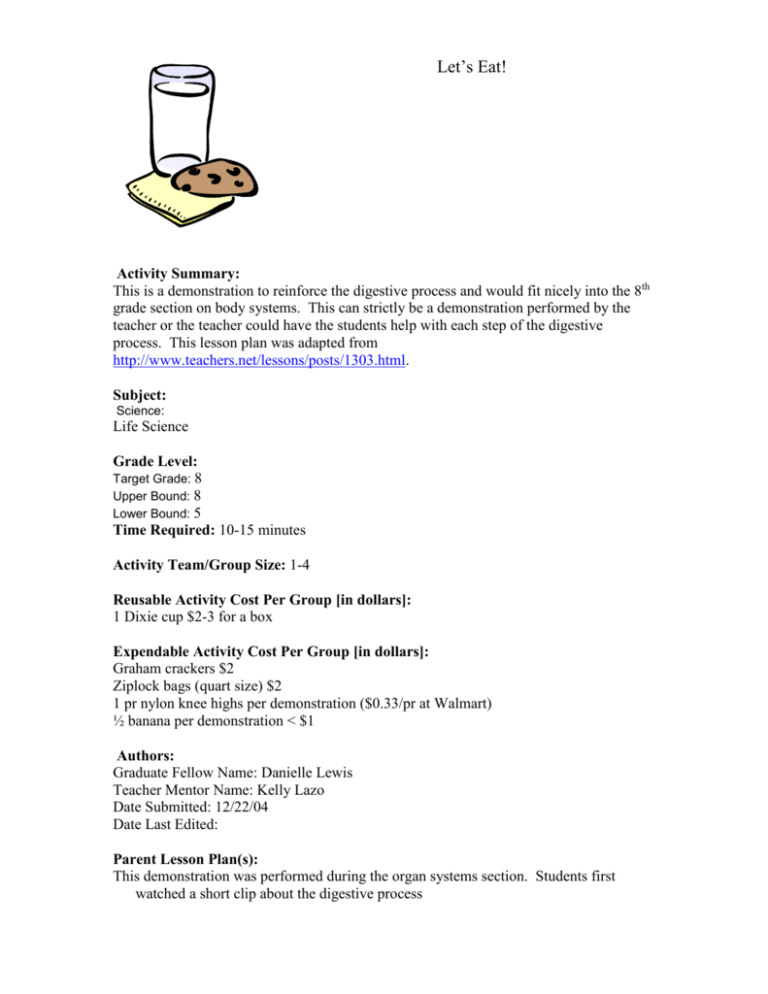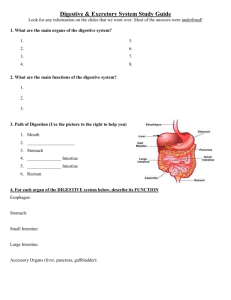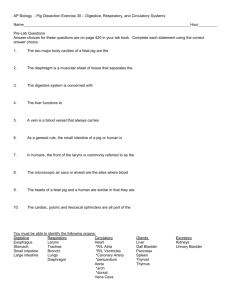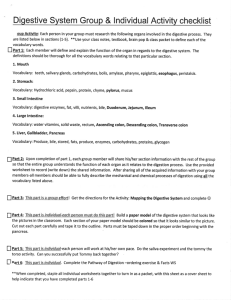Digestion Lesson Plan
advertisement

Let’s Eat! Activity Summary: This is a demonstration to reinforce the digestive process and would fit nicely into the 8th grade section on body systems. This can strictly be a demonstration performed by the teacher or the teacher could have the students help with each step of the digestive process. This lesson plan was adapted from http://www.teachers.net/lessons/posts/1303.html. Subject: Science: Life Science Grade Level: Target Grade: 8 Upper Bound: 8 Lower Bound: 5 Time Required: 10-15 minutes Activity Team/Group Size: 1-4 Reusable Activity Cost Per Group [in dollars]: 1 Dixie cup $2-3 for a box Expendable Activity Cost Per Group [in dollars]: Graham crackers $2 Ziplock bags (quart size) $2 1 pr nylon knee highs per demonstration ($0.33/pr at Walmart) ½ banana per demonstration < $1 Authors: Graduate Fellow Name: Danielle Lewis Teacher Mentor Name: Kelly Lazo Date Submitted: 12/22/04 Date Last Edited: Parent Lesson Plan(s): This demonstration was performed during the organ systems section. Students first watched a short clip about the digestive process http://www.kidshealth.org/kid/how_the_body_works.html and had also finished writing vocabulary for the digestive system, so they were familiar with the terms. Activity Introduction / Motivation: Tell the students that they are going to see digestion in progress. If you are allowed to give food out in class, give them a small piece of graham cracker and then launch into the demonstration as they are eating. This is not necessary but it helps them visualize the process. Activity Plan: 1. Place a graham cracker in a Ziploc bag and ask the students, what happens when they first start to eat anything? The food goes into their mouth. 2. Now have student #1 come up and crunch the graham cracker with the Ziploc bag closed and ask them what does this simulate? Chewing. 3. Where does food go next? Esophagus …And then where? Stomach 4. Add a banana and water to the bag, tell them that you decided to have a banana with your graham cracker. Add between 100 and 200 mL of water. Have student #2 squish the banana, water and graham cracker in the bag carefully. Ask them where the water might have come from? Saliva or drinking water……What happens in the stomach? Food is broken down ….. By what? Enzymes and acid. 5. Ask student #3 to hold a pair of nylons over the Ziploc bag and the teacher should cut a small hole in the corner of the bag so that the slurry runs out into the nylon. BE SURE TO HAVE A TRAY TO CATCH THE LIQUID. Student #3 should squeeze as much of the juice out as they can. Ask the students where the food goes to next? Small intestine…… What happens there? Nutrients are absorbed by the body. The juice from the slurry will leak out of the nylon, have the students identify the juice (nutrients) and explain where the juice goes (to the body for use as energy) 6. Ask student #4 to hold a new nylon (use one that is a different color and this one should have a small slit in the toe) under the “small intestine”. The teacher should clip the small intestine so that the slurry runs into the second nylon. Ask the students where does food goes after the small intestine? Large intestine…..What happens in the large intestine? Water is absorbed, feces is formed. 7. Ask the students where does food go after the large intestine? Rectum, then the anus and then out. As they are explaining this, student #4 should squeeze the food until it gets “pooped” out. Activity Closure: Students were given a worksheet to fill out to help reinforce the lesson. Assessment: The worksheet could be used as an assessment but is likely better used as a study aid. A test over the body organs systems should be sufficient to test their knowledge. Learning Objectives: To reinforce the digestive process and the body organs associated with it. Prerequisites for this Activity: Students should be able to define the following: mouth, saliva, esophagus, stomach, small intestine, large intestine, rectum, anus Also have them define liver, gall bladder and pancreas Background & Concepts for Teachers: Students should be familiar with the parts and the function of the digestive system. This exercise was used prior to the lecture given by the teacher over digestion. This demonstration helped the students better understand what was being taught. Vocabulary / Definitions: See prerequisites Materials List: 1 Graham cracker per demonstration 1 Ziplock bag (quart size) per demonstration 2 different colored nylon knee highs. For a better effect use colors that might resemble the organs. Cut a small slit in the toe one of the nylons (this is the large intestine). ½ banana per demonstration 1 Dixie cup filled with water Tray to catch the juices Activity Extensions: During this demonstration, other aspects of the digestive process could also be discussed. The role of the pancreas, gall bladder and liver could be incorporated in the discussion. The sphincters that control the flow of food from the stomach to the small intestine could also be included. Students could also be asked to make a 3-D model of the digestive system as a project. They might be asked to include in their model, all of the parts of the digestive system, the function of the organs and two diseases associated with the digestive system. Multimedia Support and Attachments: Safety Issues: None, just be sure to have a tray handy and pick your students carefully or the demonstration could get messy. Troubleshooting Tips: Activity Scaling: References: This exercise was adapted from, Aaron Lichtig, West Riviera Magnet Elemenary School: http://www.teachers.net/lessons/posts/1303.html See the Peer site on organ systems for additional info: http://peer.tamu.edu/curriculum_modules/OrganSystems/module_5/index.htm Cool animations on how each organ system works: http://www.kidshealth.org/kid/how_the_body_works.html









